B2B Social Media Strategy Content Tips
4.9 billion people globally use social media. However, not all of those individuals are your target customers. If you’re a B2B brand, you need to be focusing on targeting the businesses who use your products/services, which requires strategies and techniques that are different from a B2C audience. Here’s where a B2B social media strategy can help.
B2B social media marketing is a strategy for promoting your brand on social media platforms (e.g., Facebook, LinkedIn, X, Instagram, YouTube). B2B brands use social media marketing to showcase their products and services, engage with customers, and share news and thought leadership.
Sharing content is particularly important for a strong B2B social media strategy. B2B social media statistics show that 95% of B2B marketers use social content as part of their content marketing strategy. These marketers know that high-quality content is a key part of an effective B2B social media strategy, which can help them best reach, engage with, and provide value to their audiences.
In this article, we’ll share several types of B2B marketing content that you can add to your B2B marketing mix, the benefits of employee advocacy, plus some social media marketing software that can help streamline the marketing process.
B2B Social Media Marketing
Having a social media presence is not enough to engage your B2B audience. Your social media B2B strategy needs relevant, engaging content to share with your audience to spark engagement. More importantly, you need to get the right eyes on your content (e.g., decision-makers). Your brand can have the best content in the world, but if your target group doesn’t see it, it won’t make an impact on your social marketing efforts.
So, we’re going to help you develop a B2B content marketing strategy to supplement your social media marketing.
B2B Content Marketing Strategy
Content marketing is a marketing strategy that companies use to create high-quality, relevant content for their audiences. Content forms can include blogs, videos, images, infographics, and case studies.
To develop a strong B2B content marketing strategy, you’ll need to get clear on who you want to reach, how you are going to reach them, and what you want them to do.
Research Your Audience
Before you begin with the tactics and type of content you hope to create, you need to understand your audience. Who are you writing this content for? Where do they typically tend to hang out? And what types of problems and solutions are going to catch their attention to read further? What content resonates best with them?
When you better understand your audience, not only can you speak their language, but you won’t waste your time producing content for a platform that your audience isn’t on.
Set Goals
Setting a goal helps you determine the path of your content. For example, you might write a top-of-the-funnel blog post where the main goal is to get the person to download a template at the end of the post (with relevance to the topic they just read about). Or, you might create a video showing step-by-step how to execute a specific task with your product or service. Setting goals keeps your content clear and crisp on what is the expected outcome of a conversion.
Determine Pillar Content and Content Types
Pillar content is a topic you want to be known for, or an authority on. Supporting content gets to the finer points, supporting your pillar content and driving traffic to your pillar pages. The pillar page might be the main landing page you want your customers to convert on, whereas all other supporting content and content types (i.e. social media posts, eBooks, etc.) drive traffic back to the pillar page.
Use a Content Calendar
Leveraging a content calendar helps keep you clear on what content you have going out and when. It’s a good practice to understand when you have content live and on which channels so that you can make the most out of your content channels.
Create a Content Marketing Workflow
Now that you have captured their attention, what do you want to do with them? Ideally, you’re moving them down the funnel to a conversion page or an authority page, much like Lashay Lewis of Authority Plug recommends here:
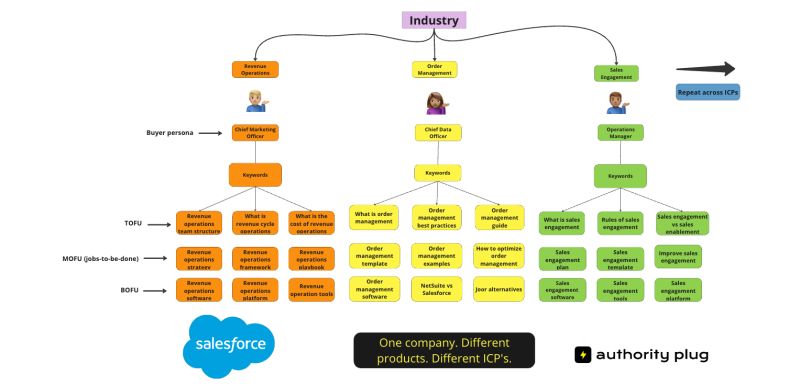
Source: Lashay Lewis
Tailor Your Content to the Social Platform
When you research your audience demographics, preferences, pain points, and behavior on each platform, it helps create better content that resonates and meets their needs. Leverage analytics, surveys, and feedback to create the most compelling content for each network.
Measure Engagement and Adjust
Is every piece of content going to hit a home run? Probably not. You’ll need to reassess and determine if you have the right content, at the right place, and at the right time. For example, Airbnb realized content coming from Brian Chesky, their CEO, outperforms announcements from their branded social handles. So, they make their announcements first on the employee social channels, then the corporate socials.
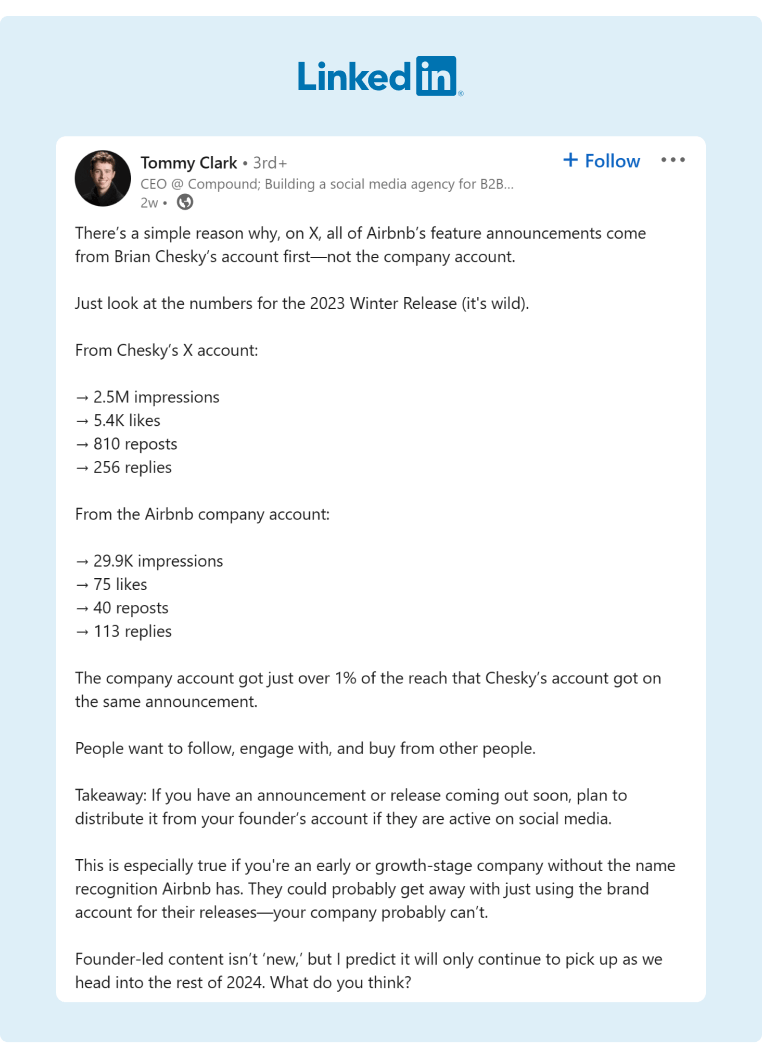
Source: Tommy Clark
B2B Social Media Content Ideas
For B2B brands, content marketing on LinkedIn is a particularly valuable marketing strategy. 96% of B2B marketers use LinkedIn to target decision-makers in specific roles and industries. Decision-makers are the individuals who are looking for relevant information on the products and services that your company can potentially provide.
Let’s take a look at some B2B social media content ideas that you can use on LinkedIn to appeal to decision-makers:
- Helpful Content. Actionable tips that can help solve a pain point will resonate with your audience. These tips can be formatted as a simple text post, brief video, or image carousel.
- Current Events. Lean into your role as a thought leader and share your expertise on a current event or trend that’s relevant to your industry.
- Live Company Events. Whenever you host a live company event, share a link to watch in real-time and a replay link to gain even more views.
- Product Releases. Launching a new product or service? Share the news! A product video demonstrating how it works along with its benefits is a creative way to spur engagement and spread the word.
- Employee User-Generated Content. Content from employees is always viewed as more genuine and authentic. Encourage your employees to generate content that you can repost, which brings us to employee advocacy on social media.
Employee Advocacy on Social Media
Employee advocacy on social media is a social marketing strategy where employees share your brand’s messages and content with their professional networks.
When brands implement employee advocacy programs, they transform their employees into brand ambassadors who amplify brand awareness, build trust, and boost credibility.
Benefits of Employee Advocacy
Here are a few of the benefits of employee advocacy:
- High-Quality Brand Awareness. Content shared by your employees will be viewed as more genuine than a branded ad.
- Generate New Leads. By using employee advocacy for social selling, you’ll be sharing relevant content (instead of cold calling/messaging). In turn, you’ll attract the right prospects to your brand and generate new leads.
- Attract Top Talent. Employer branding on social media is a great way to attract new talent. In fact, 79% of job seekers use social media for their job search.
- Customer Retention. Increasing your social engagement and sharing helpful content will go a long way with customers, helping to improve customer retention.
- Reduce Advertising Cost. Using employee advocacy to advertise can help save on advertising costs (e.g., traditional and digital marketing). The only potential costs are incentives for employees to participate (e.g., gift cards) and the cost of an employee advocacy platform.
Employee Advocacy Platform
Employee advocacy on social media can also include having your employees create their own content and posting it to their social networks. However, for those less confident employees who want to get involved on social media but maybe don’t know what to say, platforms like these really help with sharing B2B social media content. An employee advocacy platform not only helps streamline the content creation and distribution process, but it makes it super easy for Members to complete, too.
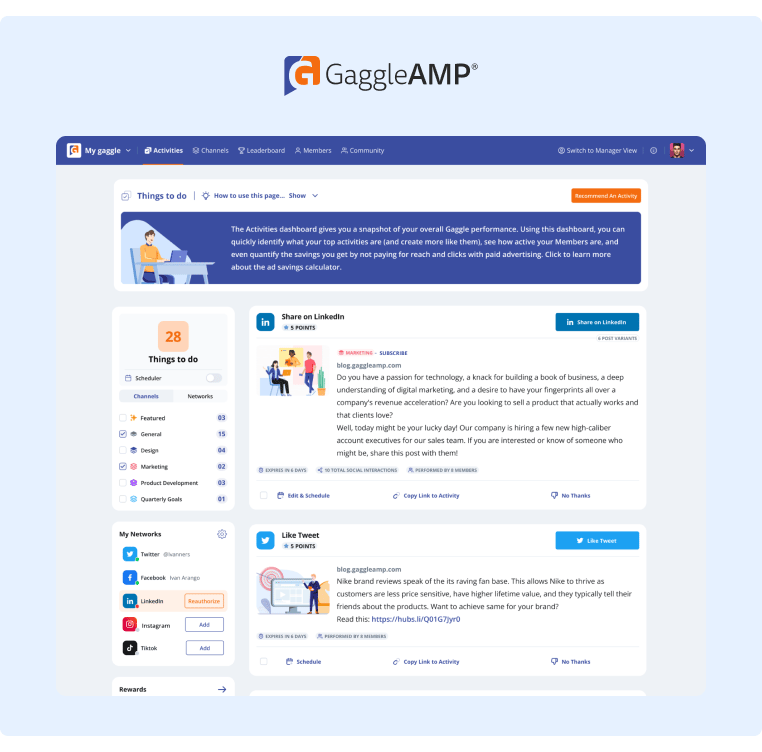
There are many social media tools out there, so let’s take a look at how using the right one can benefit your B2B social media strategy.
Social Media Marketing Software
As you build out your B2B social media strategy, consider investing in social media marketing software. There are many social media tools out there, so you’ll want to look for one that best fits your B2B social media strategy.
The best B2B marketing campaigns will need a platform that helps create and distribute content, encourages employees to share that content with their networks, and provides robust analytics to see what content on what social platforms is resonating.
An employee advocacy platform like GaggleAMP can help you achieve those social media for B2B goals.
Here’s a quick overview of how GaggleAMP’s platform works:
1. Select an Engagement Activity: Each engagement activity is categorized by social media platform and includes the specific action (like, comment, share, etc.). This makes it easy for employees to know exactly what action to take and lets social media managers concentrate engagement efforts.
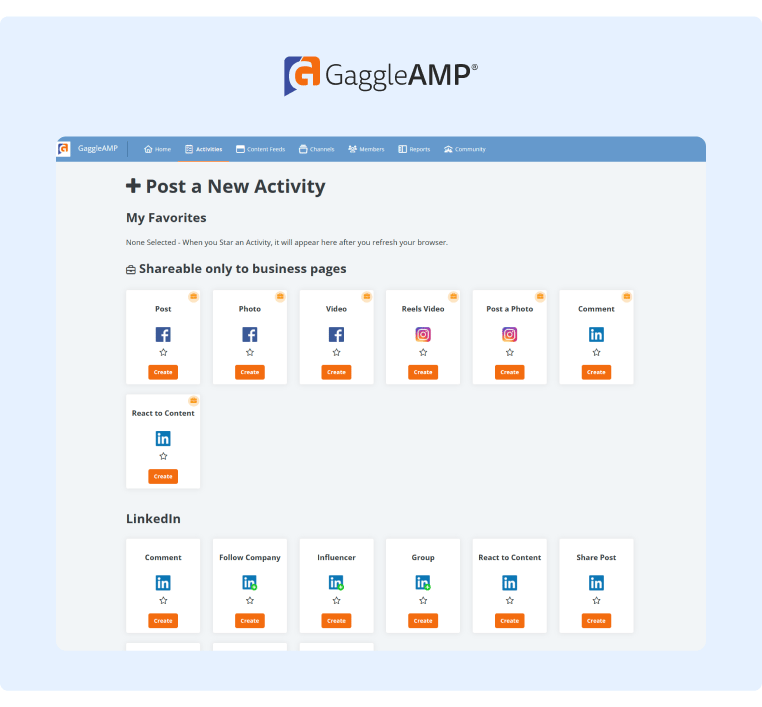
2. Fill Out the Engagement Activity. Include a due date, and specific content instructions, or even create pre-written text for the employee with the AI-power paraphrasing tool.
3. Assign the Engagement Activity. Assign the task to an employee or group of employees, then recipients will receive a notification (via Slack, Microsoft Teams, or email) that they have an engagement activity. They can then log into their personal Gaggle, view their engagement activities, and schedule them for publishing.
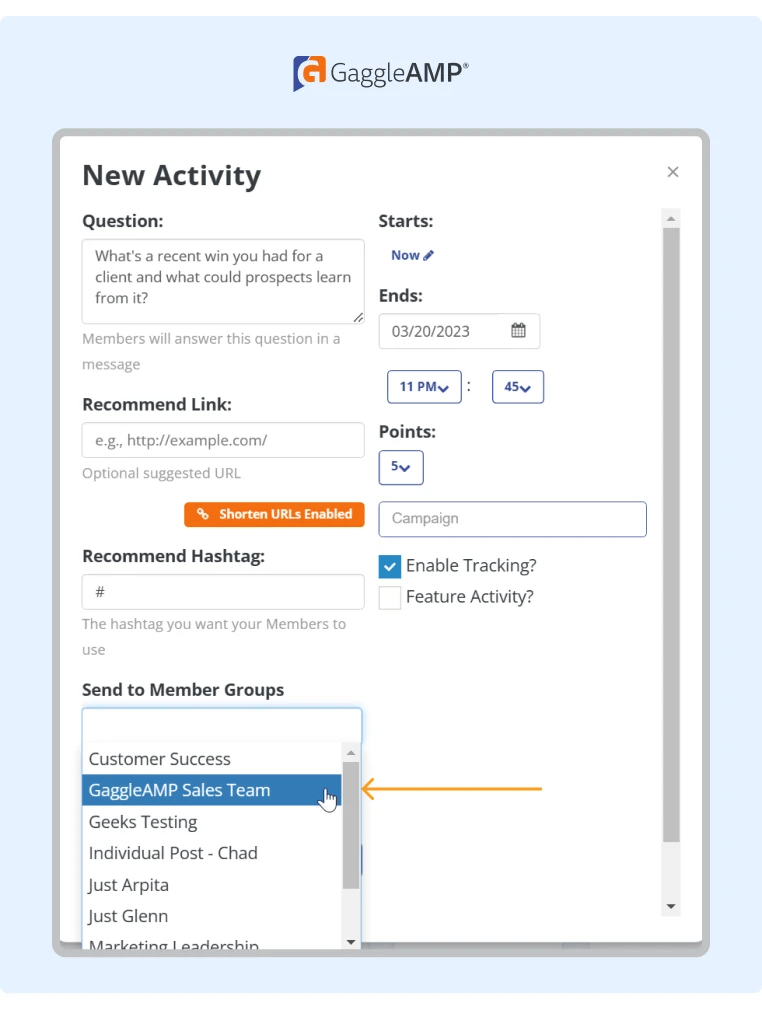
4. Review Analytics. GaggleAMP also has a detailed analytics dashboard that shows not only which employees are most engaged, but also which campaigns were most successful and other helpful insights to improve future employee advocacy campaigns.
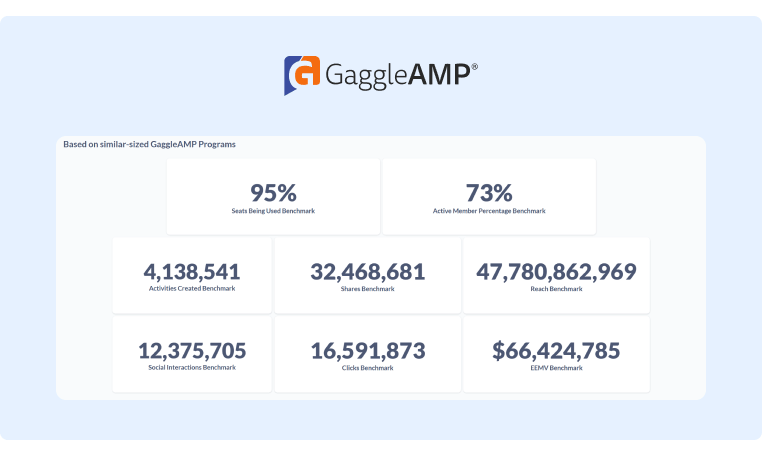
GaggleAMP also has gamification features to help you get that all-important employee buy-in for successful employee advocacy.
Amplify Your B2B Social Media Strategy With GaggleAMP
Ready to strengthen your B2B social media strategy with an employee advocacy tool like GaggleAMP? Our platform gives you the tools to create and distribute content along with robust social media analytics to see your brand reach and engagement.
To see our platform in action, schedule a demo today.









